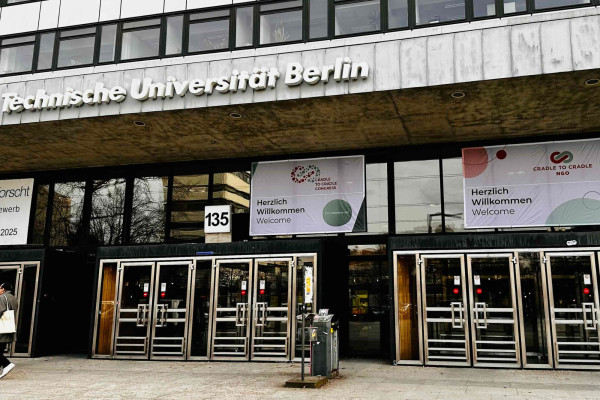
Vugge til Vugge Awarded Børsen Gazelle — Two Ye…
Vugge til Vugge has been honored by Denmark's leading financial publication with the Børsen Gazelle Award 2025, presented to the country's fastest-growing companies.
Read more →When a certification evolves into a strategic tool, it begins to shape how a company thinks, operates, and leads. For Danish global leader in furniture handles, furnipart, that moment came with Version 4 of the Cradle to Cradle Certified® Product Standard.

Comet furniture handle by furnipart
"With Version 4, Cradle to Cradle Certified® has come to life in the organisation." This powerful statement by CEO Rasmus Byriel marks a turning point in how product certification can move beyond compliance to drive real transformation. At furnipart, the Cradle to Cradle Certified® framework has become more than a label—it has become a living system embedded across teams, processes, and decision-making.
"With Version 4, Cradle to Cradle Certified® has come to life in the organisation."
furnipart's commitment to sustainability goes beyond product design. Through its long-standing engagement with the Cradle to Cradle Certified® framework, the Danish furniture component designer has redefined how certification can drive strategy, reshape supply chain partnerships, and prepare for increasing demands related to scope 3 emissions.
This case study outlines how Cradle to Cradle Certified® evolved from a certification into a company-wide management tool, transforming not only how furnipart makes its products, but also how it leads its value chain and influences global manufacturing practices.
furnipart’s journey with Cradle to Cradle design and certification began in 2016 as part of the EU-funded "Rethink Business" initiative in Denmark. Initially seen as an opportunity to document sustainability efforts across the company’s production sites, the certification soon evolved into something far more foundational.
"We don’t just certify products. We use Cradle to Cradle Certified® as the foundation behind our entire ESG strategy," said CEO Rasmus Byriel.
By focusing on continuous improvement and structured progress, the certification became a framework for internal planning, long-term development, and data-driven management.
furnipart has leveraged Cradle to Cradle Certified® not just to meet existing requirements, but to anticipate future ones. Data collected during certification feeds directly into the company’s ESG metrics, science-based targets, and preparation for scope 3 reporting.
"All our sustainability data connects back to Cradle to Cradle Certified®," said Compliance and Sustainability Coordinator Marianne Pia Jensen. "It helps us anticipate what’s coming and strengthens our position with customers."
This includes risk assessments, action plans, and supplier documentation that support furnipart’s readiness for future regulatory demands and industry expectations.
"All our sustainability data connects back to Cradle to Cradle Certified®. It helps us anticipate what’s coming and strengthens our position with customers."
With production based in China, furnipart faced the challenge of proving the quality and ethics of offshore manufacturing. Cradle to Cradle Certified® provided a credible and structured way to do this.
"Our position has always been: Chinese production can be just as responsible. But we needed to prove it," said Rasmus.
A local furnipart representative supports communication with suppliers, helping bridge language and cultural gaps. The certification process — with its emphasis on audits and documentation — has built confidence and accountability in a high-risk manufacturing context.
furnipart’s first certification in 2018 felt like a goal. The latest recertification, under the more rigorous Version 4 of the standard, felt like the beginning of a cultural shift.
"This time, we know we’ve made commitments that will shape how we work for years to come," said Rasmus.
The process pushed furnipart to develop and roll out long-term strategies, internal training, and clearer follow-up systems. What started as a project is now embedded in how the company operates.
China is considered a high-risk location for human rights in international social accountability standards, which is also reflected in the Social Fairness category of the Cradle to Cradle Certified® Product Standard. This meant furnipart had to go far beyond basic audits. The company obtained performance data generated by qualified third-party social auditors on a wide range of human rights aspects as well as extended elements such as working hours, wages, policies, and ethics protocols across multiple factories.
"It was challenging, but it also revealed good practices. Some factories had already made significant investments in worker welfare," said Marianne. “Moreover, protecting the environment is a consistent topic that deals with permits, emission controls and consumption of water and raw materials."
The process required new levels of transparency, third-party audits, and corrective action plans — all of which are now non-negotiable parts of furnipart’s onboarding process for new suppliers.

Photo credit: furnipart
furnipart is exploring recycled content, especially in metals, which are already highly recyclable. The company is also preparing for take-back systems , although challenges remain.
"It opened up important discussions on trade-offs" said Rasmus, referring to Cradle to Cradle Certified®. "Sometimes recycled materials have higher water use or carbon footprints. The important thing is that we’re now equipped to make informed choices."
In an industry where most companies cherry-pick metrics — carbon here, recycled content there — furnipart stands out for its comprehensive and coherent approach.
"Cradle to Cradle Certified® helps us speak clearly and holistically about sustainability. It gives us an edge," said Marianne.
With large customers in the furniture industry increasingly requiring Scope 3 data and science-based targets, furnipart’s structured approach positions it as a trusted and future-ready partner.
For furnipart, Cradle to Cradle Certified® is not just a label — it's a blueprint. From supply chain transparency to strategic development, the certification underpins how the company delivers on its values and prepares for tomorrow's challenges. In a shifting regulatory and market landscape, it has become a business-critical tool for leadership, resilience, and trust.

Comet furniture handle by furnipart
Read more about furnipart's sustainability strategy on the company website here.
View furnipart's Cradle to Cradle Certified® products on the Cradle to Cradle Products Innovation Institute's Product Registry.
a. Elimination of discrimination with respect to employment and occupation including, but not limited to, ethnicity-, race- and gender-based discrimination,
b. Elimination of harassment and abuse,
c. Elimination of all forms of forced or compulsory labor, or activities that are known to lead to forced labor (e.g., human trafficking),
d. The abolition of child labor and adequate protections for workers above the legal working age and below age 18,
e. Prevention of excessive working hours,
f. Freedom of association and collective bargaining,
g. Safe and healthy work, including:
i. Access to water, sanitation, and hygiene (WASH),
ii. Emergency preparation and response,
iii. Hazardous materials handling procedures,
iv. Management systems that address health and safety risks, and
v. Appropriate building construction, electrical, and fire safety.
h. Provision of the legal minimum wage and all legally mandated benefits including employer contributions for social security benefits and services,
i. Aspirations for the provision of a living wage that covers the necessities for life as defined in its local context (e.g., food, water, housing, health care, education, clothing, transportation, child care, discretionary income),
l. Fair and ethical business practices, including anti-corruption/bribery.

Vugge til Vugge has been honored by Denmark's leading financial publication with the Børsen Gazelle Award 2025, presented to the country's fastest-growing companies.
Read more →
The EU Green Claims Directive raises the bar for environmental communication. Discover how C2C Certified® helps substantiate claims with confidence.
Read more →
Takeaways from the Cradle to Cradle Congress 2025: Industry leaders drive change, making circular strategies a competitive advantage.
Read more →